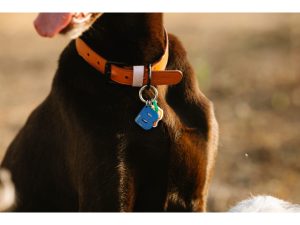
Terry Lackmeyer
Customer Service Representative

Before we talk about the search methods to get your pet back home again, let’s talk about what needs to be done to help ensure their safe return if they get lost, as well as precautions to take to prevent them from getting lost. In the world of pet recovery, the most important thing is identification, Identification, IDENTIFICATION.
Make sure that your pet wears a collar tag that includes their name, your name, address, and phone number. If you are not comfortable having your address on the tag, at least include your name and phone number. Collars are available where you can have your pet’s name and your phone number imprinted on the collar, so you don’t need to worry about the loss of the tag.
Have your pet microchipped. The microchip contains valuable information about your pet that can be scanned by any animal shelter, pet store, or veterinary clinic with a scanner. Keep a license on your dog. Not only is it the law in most areas, but also it provides your contact information when someone finds your dog and contacts authorities. Consider having your dog tattooed in conjunction with the license. Many areas offer lifetime licenses that are linked with the tattoo. You purchase the license once and it is good for the life of your dog. The tattoo can easily be put on your dog during the spaying or neutering procedure. Above all, be sure to keep all information updated if you change your address or phone number.
Pets often go missing during a holiday event or social gathering. The loud booming sound of fireworks spells trouble for many pets – they will do anything to escape those sounds. The same goes for thunder during seasonal storms. If your pet is one that gets frightened or extremely anxious with these noises, be sure they are secured safely inside your home. You may want to talk with your veterinarian about getting a sedative to be used during these anxiety-provoking events.
Likewise, be sure your pet is safely secured in a room or is closely monitored during parties or large gatherings. Pets can get very excited with all the different people and easily scoot out a door or gate, or guests could unintentionally leave a door or gate open. You don’t want to ruin a great celebration with a lost pet.
Unfortunately, taking all these precautions may not prevent your pet from getting lost, but hopefully they will help to bring your pet home quickly and safely. In the meantime, if your pet has gone missing here are some actions to take to help get them home.
Start by checking your home to be sure your pet is not hiding within the house. Check under beds, in closets, and behind and under furniture. Cats, especially, can get shut into closets or jump into drawers when you’re not looking and be trapped there. The same goes for small dogs.
Keep updated pictures of your pet. While pictures of Rover or Fluffy lounging upside down on the sofa are entertaining and cute for you, distinct photos enabling others to easily identify the pet is who you are looking for. You will need several photos, including a full body shot taken from the side along with a relatively close head shot. Make sure the photos are clear and sharp. Make copies of the photos to hand out and include your contact information on the back.
Canvas your neighborhood and alert all the neighbors. Search like you never have before. Repeatedly call your pet as you search and if they have a favorite phrase they respond to, use it. If your pet adores treats or loves the car, try to lure them out with that phrase. “Fido, let’s get a treat” or “Fido, want to go in the car?” Investigate every nook and cranny, under cars, backyards, and porches. Knock on every door and talk to neighbors.
Bring copies of the photos to show to every person with whom you speak in your neighborhood. Leave a copy of the photos with them, along with a contact number where you can be reached should they spot your pet. Neighborhood children are great scouts. Be sure to talk with them and ask them to be on the lookout for your pet.
Next, contact all the local animal shelters, animal control, rescue groups, grooming shops, and veterinary hospitals in your area. Be sure to contact your local police as well. Leave the photos with your contact information at every place your stop. Check back with the shelters daily. Be sure to connect with social media networks and post a listing of your lost pet. Most communities have Facebook pages where you can post information about lost pets. Be sure to include pictures and information about where and when your pet went missing.
Create a flyer to post anywhere and everywhere in your area. Make the poster heading large and easy to read from a distance. Include a clear current picture of your pet. List the name, weight, sex, and coloring. Include any distinguishing features about your pet, such as scars or eye color. Indicate if the pet is microchipped. If the pet requires daily medications, include that as well. Note where and when the pet went missing. Above all, be sure to include your contact information. Laminate these posters so when posted outside on poles or trees they will not break down due to adverse weather. Post these flyers everywhere you can.
While social media may be the modern form of communication, you do not want to leave any stone unturned so be sure to submit an ad to your local newspaper’s lost and found section. Include a short description of the pet and your contact information.
Be sure your voice mailbox is active and taking messages. You don’t want to miss that all important call that your pet was spotted or found. Monitor your voice mail frequently and be sure there is enough storage space for additional messages.
Check back daily with all the shelters, veterinarians, shops, businesses, and local authorities with which you have posted information. Above all, don’t give up. Hopefully, by following thorough with all these suggested steps, your pet will be returned to you safe and sound and that will make both of you happier beyond belief!
